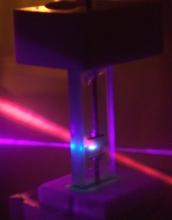Multimedia Gallery
Liquid cell with immersed electrodes
Two laser beams cross in a glass cuvette that holds a transparent liquid. Electrodes are suspended in the glass cell so that an electric field can be applied in the region where the laser beams interact with the molecules in a solution. The cell was used to observe a new electrooptic effect.
More about this image
This image shows a cuvette made from quartz glass that researchers at Cornell University used to observe a new electrooptic effect. A red and a blue laser beam from a femtosecond laser can be seen crossing in the cuvette between electrodes suspended from above and below. The light pulses are so intense that they cause the molecules in the solution to emit radiation at the sum of the incident frequencies. Here the sum-frequency is in the ultraviolet and is not seen in the image. This nonlinear optical process is known as "sum-frequency generation." For symmetry reasons, sum-frequency generation can in a liquid only take place if the molecules are handed.
Just as gloves and hands come in mirror-image pairs (a left and a right), many molecules can exist in left- and right-handed forms. This property of handedness is called chirality and most biological molecules including proteins, DNA and their building blocks are chiral. Surprisingly, all living organisms contain only left-handed amino acids and right-handed sugars. This exclusive homochirality (having all molecules of one type of the same handedness) has the important consequence that the biological and pharmaceutical activity of many molecules is often directly related to their chirality. The fundamental importance of chirality in chemistry and biology requires probes that are sensitive enough to distinguish between the two mirror-image forms of a chiral molecule, and optical methods are often the only practical physical means to do so.
Using the liquid cell shown in here, researchers at Cornell University have showed that the application of a static electric field to sum-frequency generation can be used to distinguish between the left- and right-handed forms of chiral molecules in solution.
This research was conducted with the support of a National Science Foundation grant (CHE 00-95056). (Year of image: 2003)
Credit: Kale Beckwitt and Peer Fischer, Department of Applied and Engineering Physics, Cornell University
Images and other media in the National Science Foundation Multimedia Gallery are available for use in print and electronic material by NSF employees, members of the media, university staff, teachers and the general public. All media in the gallery are intended for personal, educational and nonprofit/non-commercial use only.
Images credited to the National Science Foundation, a federal agency, are in the public domain. The images were created by employees of the United States Government as part of their official duties or prepared by contractors as "works for hire" for NSF. You may freely use NSF-credited images and, at your discretion, credit NSF with a "Courtesy: National Science Foundation" notation.
Additional information about general usage can be found in Conditions.
Also Available:
Download the high-resolution JPG version of the image. (1.2 MB)
Use your mouse to right-click (Mac users may need to Ctrl-click) the link above and choose the option that will save the file or target to your computer.



